1. Early Life
Prince Carl's early life was shaped by his Danish royal upbringing and his naval career, which prepared him for a life of service that would eventually lead him to the Norwegian throne.
1.1. Birth and Family
Prince Carl was born on 3 August 1872 at Charlottenlund Palace, his parents' country residence north of Copenhagen, during the reign of his paternal grandfather, King Christian IX. He was the second son of Crown Prince Frederik of Denmark (the future King Frederick VIII) and his wife Crown Princess Louise of Sweden. His father was the eldest son of King Christian IX and Louise of Hesse-Kassel, while his mother was the only daughter of King Charles XV of Sweden (who was also King of Norway as Charles IV) and Louise of the Netherlands.
At birth, he was named Christian Frederik Carl Georg Valdemar Axel and was known as Prince Carl, a namesake of his maternal grandfather. He was baptized at Charlottenlund Palace on 7 September 1872 by the Bishop of Zealand, Hans Lassen Martensen. Carl belonged to the Schleswig-Holstein-Sonderburg-Glücksburg branch of the House of Oldenburg. The House of Oldenburg had been the Danish royal family since 1448, and between 1536 and 1814, it also ruled Norway as part of the Kingdom of Denmark-Norway. The family had connections with Norway dating back to the 15th century. Several of his paternal ancestors had been kings of Norway in union with Denmark and sometimes Sweden, including Christian I, Frederick I, Christian III, Frederick II, Christian IV, and Frederick III. Frederick III integrated Norway into the Oldenburg state with Denmark, Schleswig, and Holstein. His subsequent paternal ancestors had been dukes in Schleswig-Holstein. Christian Frederick, who was King of Norway briefly in 1814 and the first king of the Norwegian 1814 constitution and struggle for independence, was his great-granduncle.
1.2. Childhood and Education
Carl was raised with his siblings in the royal household in Copenhagen. He grew up between his parents' residence in Copenhagen, the Frederick VIII's Palace (part of the Amalienborg Palace complex), and their country residence, Charlottenlund Palace, located by the coastline of the Øresund strait north of the city. In contrast to the common practice of the period, where royal children were raised by governesses, Crown Princess Louise herself raised the children. Under her supervision, they received a rather strict, Christian-dominated upbringing characterized by severity, fulfillment of duties, care, and order.
As a younger son of the Crown Prince, there was little expectation that Carl would become king. He was third in line to the throne after his father and elder brother, Prince Christian, and spent his early life in the shadow of his elder brother. Carl was less than two years younger than Christian, and the two princes were educated together at home by private tutors, having a joint confirmation at Christiansborg Palace Chapel in 1887.
After his confirmation, Carl pursued a military education, entering the Royal Danish Naval Academy from 1889 to 1893, graduating as a second lieutenant. He remained in service with the Royal Danish Navy until his appointment as Norwegian king in 1905. In 1894, he was promoted to the rank of first lieutenant and in 1905 to the rank of admiral. During his naval career, he participated in several naval expeditions, including one in 1904-1905 with the protected cruiser HDMS Heimdal to the Mediterranean and the Atlantic.
2. Marriage and Children
Prince Carl's personal life revolved around his marriage to Princess Maud of Wales and the birth of their only child, who would later become King Olav V.
2.1. Marriage to Princess Maud
On 28 October 1895, at the age of 23, Prince Carl became engaged to his first cousin, Princess Maud of Wales. Princess Maud was the youngest daughter of the Prince and Princess of Wales (later King Edward VII and Queen Alexandra of the United Kingdom). The Princess of Wales was Carl's aunt, being the eldest daughter of King Christian IX and Louise of Hesse-Kassel. The wedding was celebrated on 22 July 1896, in the Private Chapel of Buckingham Palace, and was attended by the bride's grandmother, the 77-year-old Queen Victoria.
After the wedding, the couple settled in Copenhagen, where Carl continued his career as a naval officer. They resided in the Bernstorff Mansion, an 18th-century Rococo style townhouse owned by Carl's uncle, King George I of Greece, situated in Bredgade adjacent to the Amalienborg Palace complex. The bride's father also gifted them Appleton House on the Sandringham Estate as a country residence for Maud's frequent visits to England.
2.2. Children
It was at Appleton House that the couple's only child, Prince Alexander, the future Crown Prince Olav and eventually King Olav V, was born on 2 July 1903.
The direct lineage of King Haakon VII through his only son, Olav V, is as follows:
| Name | Birth | Death | Notes |
|---|---|---|---|
| Olav V | 2 July 1903 | 17 January 1991 | King of Norway 1957-1991; married 1929, Princess Märtha of Sweden; had issue; descendants include Harald V of Norway |
3. Accession to the Norwegian Throne
The accession of Prince Carl to the Norwegian throne was a pivotal moment in Norway's history, marking its independence and the establishment of a new monarchy chosen by its people.
3.1. Background and Election
Following several years of disagreements on various topics, the union between Sweden and Norway, which had existed since 1814, was dissolved in 1905. The union was unilaterally dissolved by the Storting (Norwegian parliament) on 7 June, and the dissolution was later confirmed by the Norwegian people in the 1905 Norwegian union dissolution referendum held on 13 August. After weeks of negotiations, the dissolution of the union was recognized by Sweden on 23 September in the Treaty of Karlstad, mediated by the great powers of Europe. Its provisions included the full recognition of Norway's sovereignty and the abdication of the Swedish King Oscar II from the Norwegian throne. One month later, on 26 October, King Oscar II formally signed the documents recognizing Norway as an independent state and abdicated as Norwegian king.
Subsequently, a committee of the Norwegian government identified several princes from European royal houses as candidates for the vacant Norwegian crown. Although Norway had legally had the status of an independent state since 1814, it had not had its own king since 1387. Prince Carl gradually became the leading candidate, largely because he was descended from independent Norwegian kings. He also had a son, providing an heir-apparent to the throne, and the fact that his wife, Princess Maud, was a member of the British royal family was viewed by many as an advantage to the newly independent Norwegian nation.
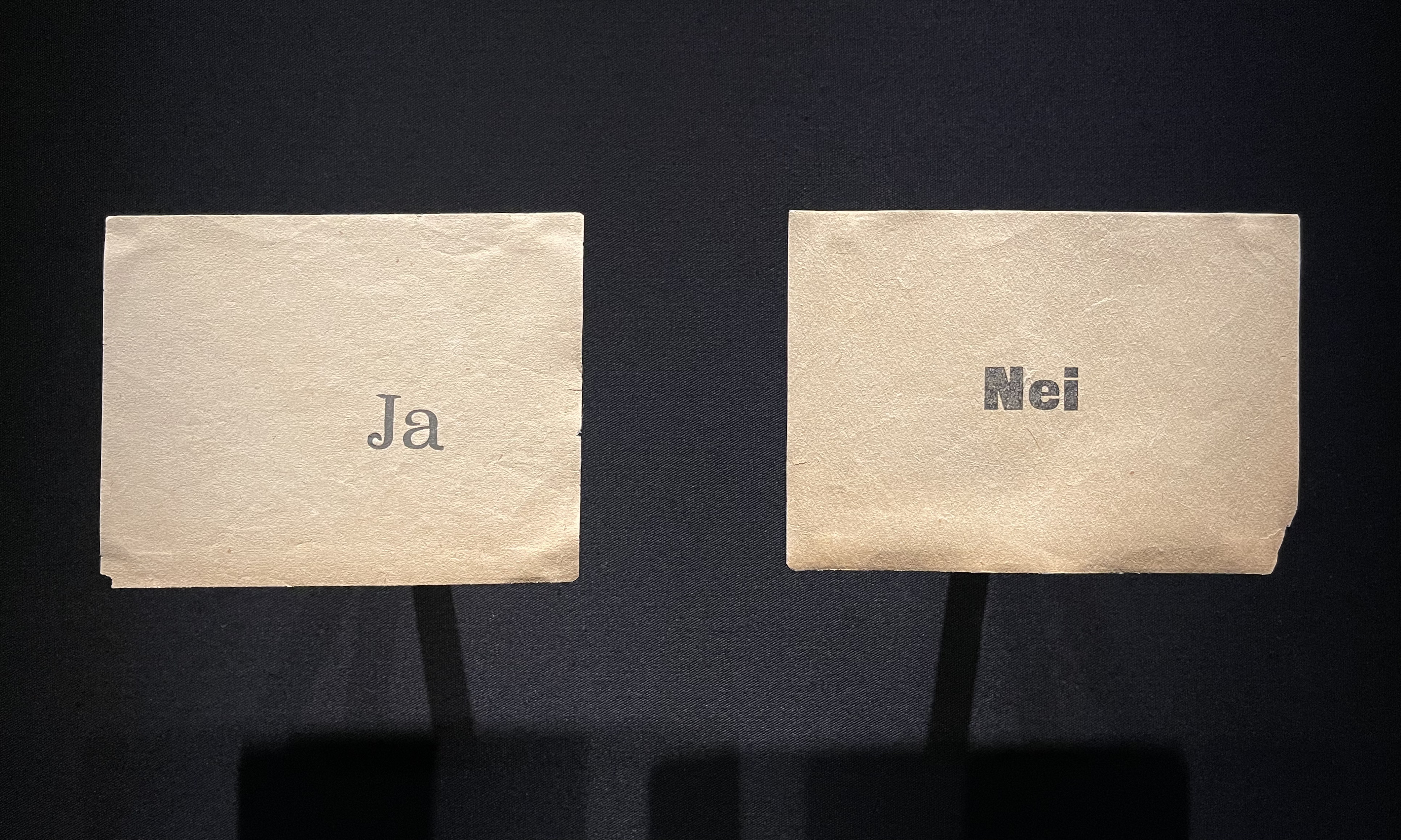
The democratically minded Prince Carl, aware that Norway was still debating whether to remain a kingdom or to switch to a republican system of government, was flattered by the Norwegian government's overtures. However, he made his acceptance of the offer conditional on the holding of a referendum to show whether monarchy was the choice of the Norwegian people. After the referendum overwhelmingly confirmed by a 79 percent majority (259,563 votes for and 69,264 against) that Norwegians desired to remain a monarchy, Prince Carl was formally offered the throne of Norway by the Storting and was elected on 18 November 1905. When Carl accepted the offer that same evening (after the approval of his grandfather, King Christian IX), he immediately endeared himself to his adopted country by taking the Old Norse name of Haakon, a name which had not been used by kings of Norway for over 500 years. In so doing, he succeeded his maternal great-uncle, Oscar II of Sweden, who had abdicated the Norwegian throne in October.
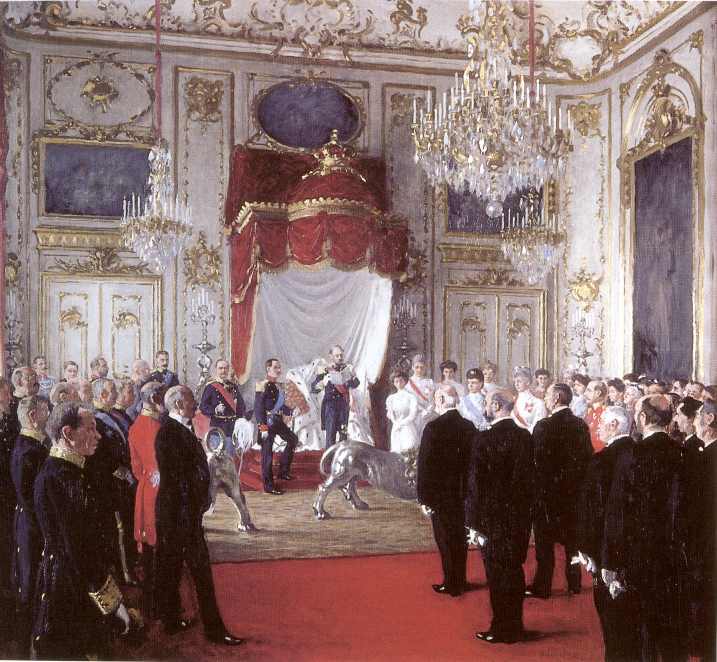
Two days later, on the morning of 20 November, a large crowd gathered outside King Haakon and Queen Maud's residence in Bernstorff's Palace in Copenhagen. The attendees greeted the royal couple as they appeared in the window and started singing the patriotic song Ja, vi elsker dette landet. Later the same day, King Christian IX of Denmark received a delegation from the Storting in an audience in Christian VII's Palace at Amalienborg. The delegation conveyed the message that the king's grandson had been elected King of Norway, while Christian IX expressed his consent to the election of Prince Carl. The head of the delegation, the President of the Storting, Carl Berner, conveyed greetings and congratulations from the Norwegian people, expressing their wishes for a happy cooperation. King Christian IX expressed his consent to the election, and Haakon VII famously replied that he was deeply affected by the responsibility if the German demand were rejected, stating he could not accept them as it would conflict with his duty as King of Norway. He asserted that he wanted to be sure that it was the people, not a party, who desired him to be king, and that his task was to unite, not divide. He concluded by dedicating his life to the good of Norway, and that with full confidence he would take as his motto: "ALL FOR NORWAY!"
3.2. Arrival in Norway and Coronation
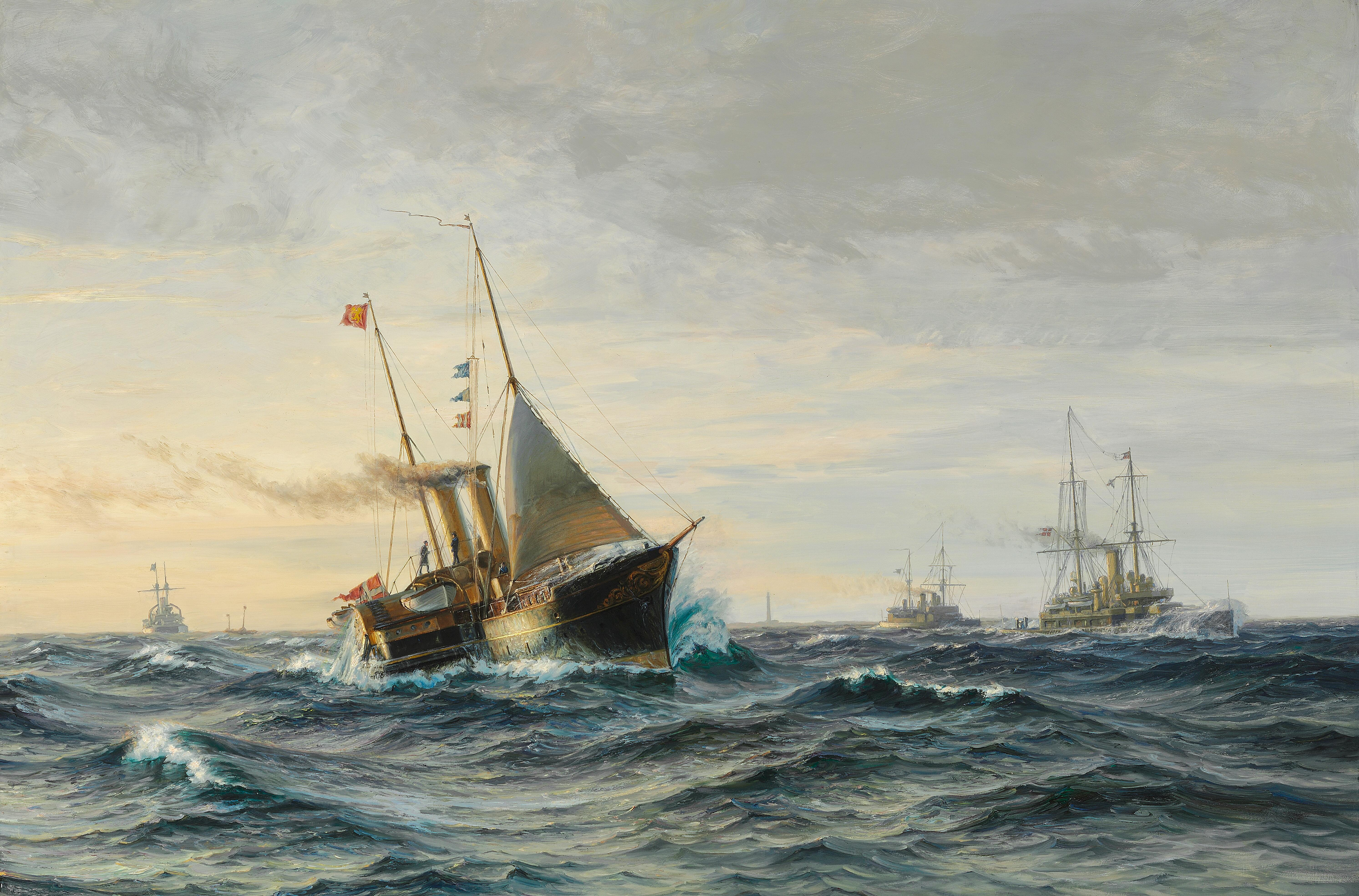
Just three days later, on 23 November, the new Norwegian royal family left Copenhagen for Norway on board the Danish royal yacht, the paddle steamer HDMY Dannebrog. After crossing the Kattegat and the Skagerrak, the Dannebrog entered the Oslofjord, where at Oscarsborg Fortress near Drøbak, the family boarded the Norwegian naval ship HNoMS Heimdal. The Heimdal then sailed the king the last part of the stretch from Drøbak, and after a two-day journey, the family arrived in Kristiania (now Oslo) early on the morning of 25 November 1905.
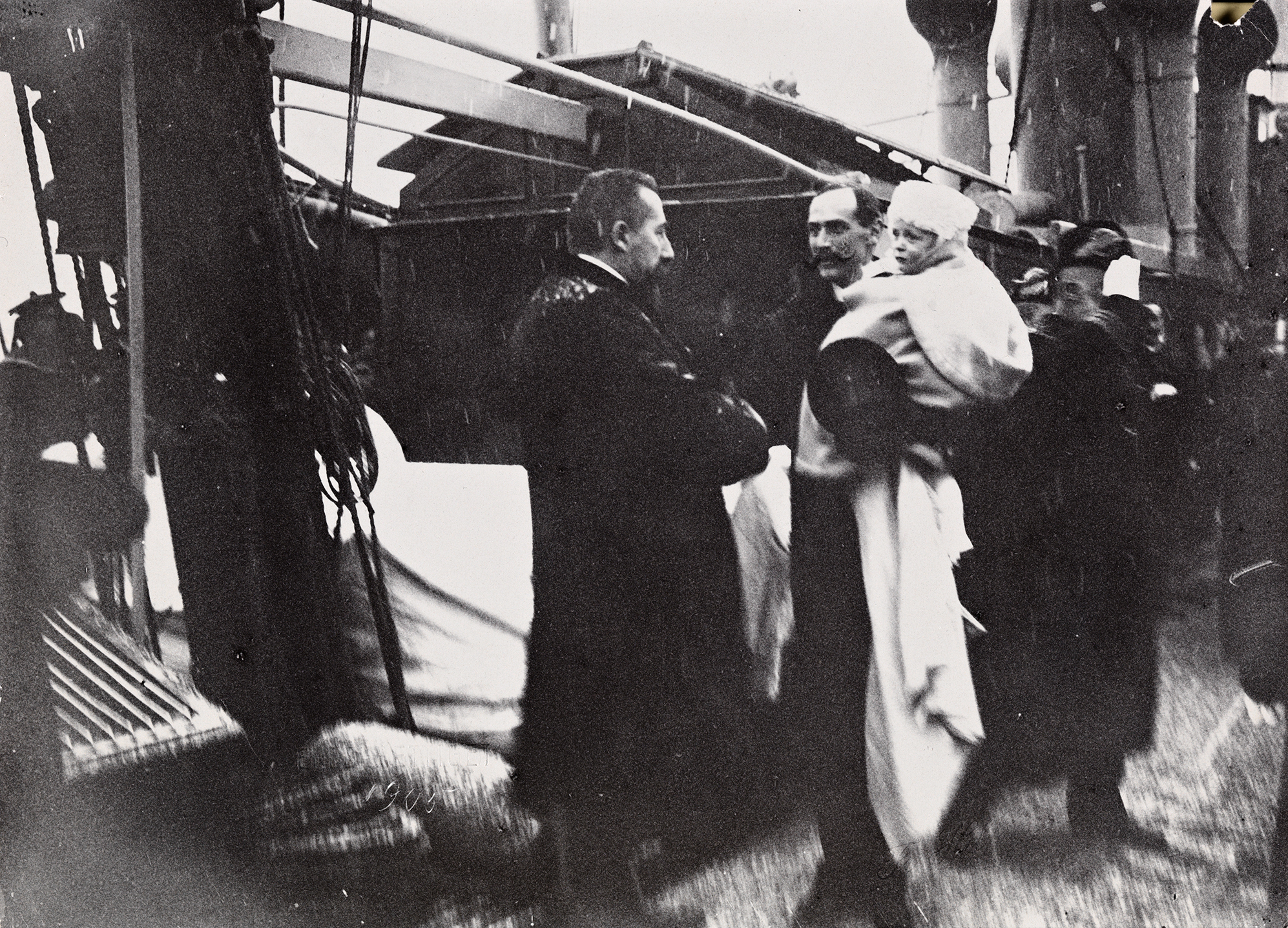
The king was received at the harbour by the Prime Minister of Norway, Christian Michelsen. On the deck of the Heimdal, the Prime Minister gave a welcoming speech to the king, stating that for almost 600 years, the Norwegian people had not had their own king, one who was entirely their own or had a home with them. He emphasized that today, Norway's young king came to build his future home in Norway's capital, chosen by a free people to lead their country, and would be completely their own. He concluded that once again, the Norwegians' king would be the strong, unifying mark for all national deeds in the new, independent Norway.
Two days later, on 27 November, Haakon VII took his constitutional oath before parliament as Norway's first independent king in 518 years. However, Norway counts 18 November, the day of his election, as the formal beginning of his reign.
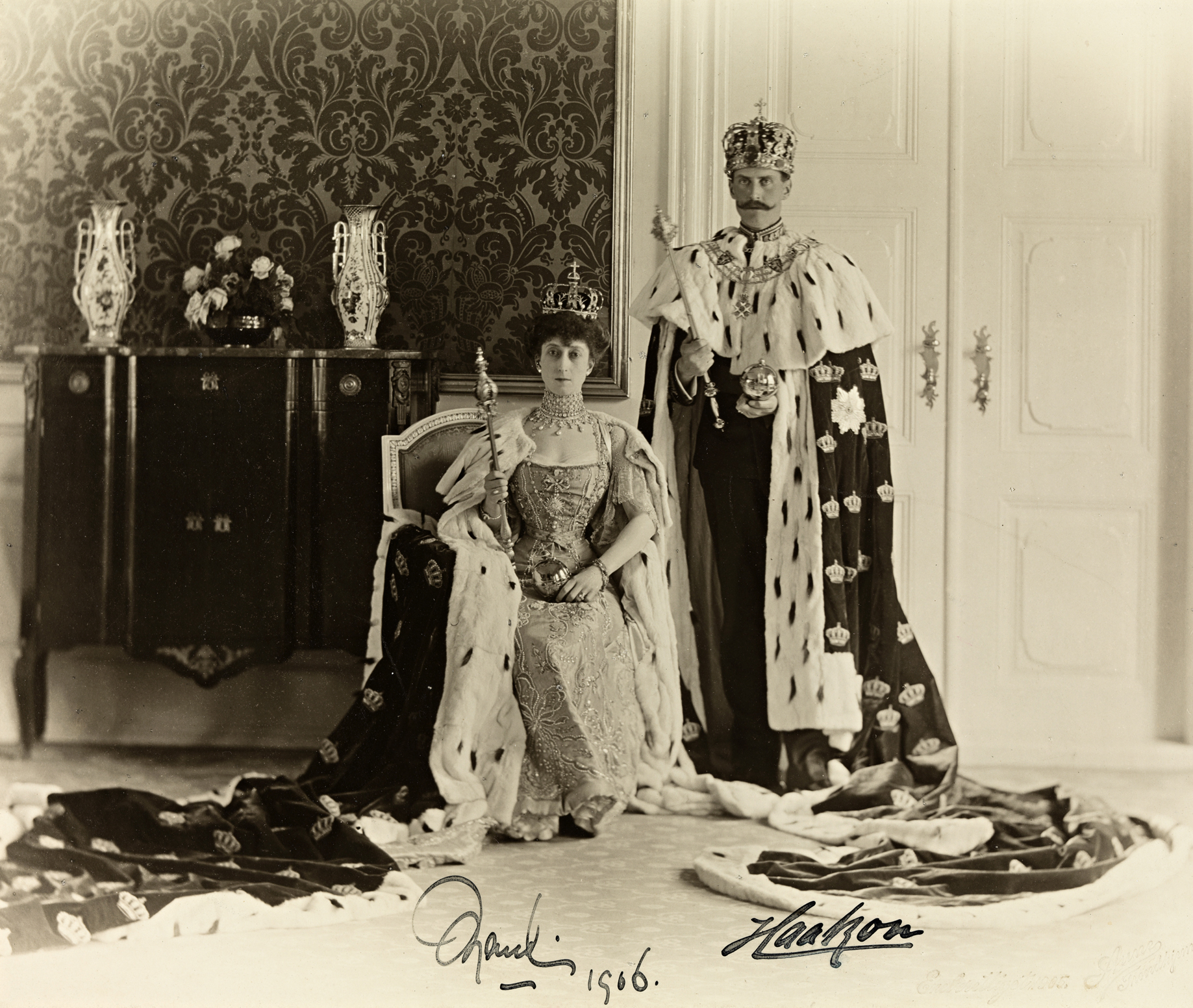
On 22 June 1906, King Haakon and Queen Maud were solemnly crowned and anointed in the Nidaros Cathedral in Trondheim by the Bishop of Trondheim Vilhelm Andreas Wexelsen. The coronation was in keeping with the constitutional mandate, but many Norwegian statesmen had come to regard coronation rites as "undemocratic and archaic". The coronation clause was deleted from Norway's constitution in 1908, and although coronations are not expressly banned under current Norwegian legislation, this became the most recent coronation of a Norwegian monarch. In the period before and after the coronation, the King and Queen made an extensive coronation journey through Norway.
The King and Queen moved into the Royal Palace in Oslo. Haakon became the first monarch to use the palace permanently, and it was therefore refurbished for two years before he, Queen Maud, and Crown Prince Olav could move in. While the Royal Palace was being refurbished, the King and Queen Maud lived their first year in Norway at the Bygdøy Royal Estate in Oslo, which they continued to use frequently as a summer residence. After the coronation, King Haakon and Queen Maud also received the estate Kongesæteren at Holmenkollen in Oslo as a gift from the Norwegian people.
4. Early Reign
During his early reign, King Haakon VII dedicated himself to establishing a modern, democratic monarchy in newly independent Norway, balancing symbolic representation with non-interference in political affairs.
4.1. Establishing the Monarchy in Independent Norway
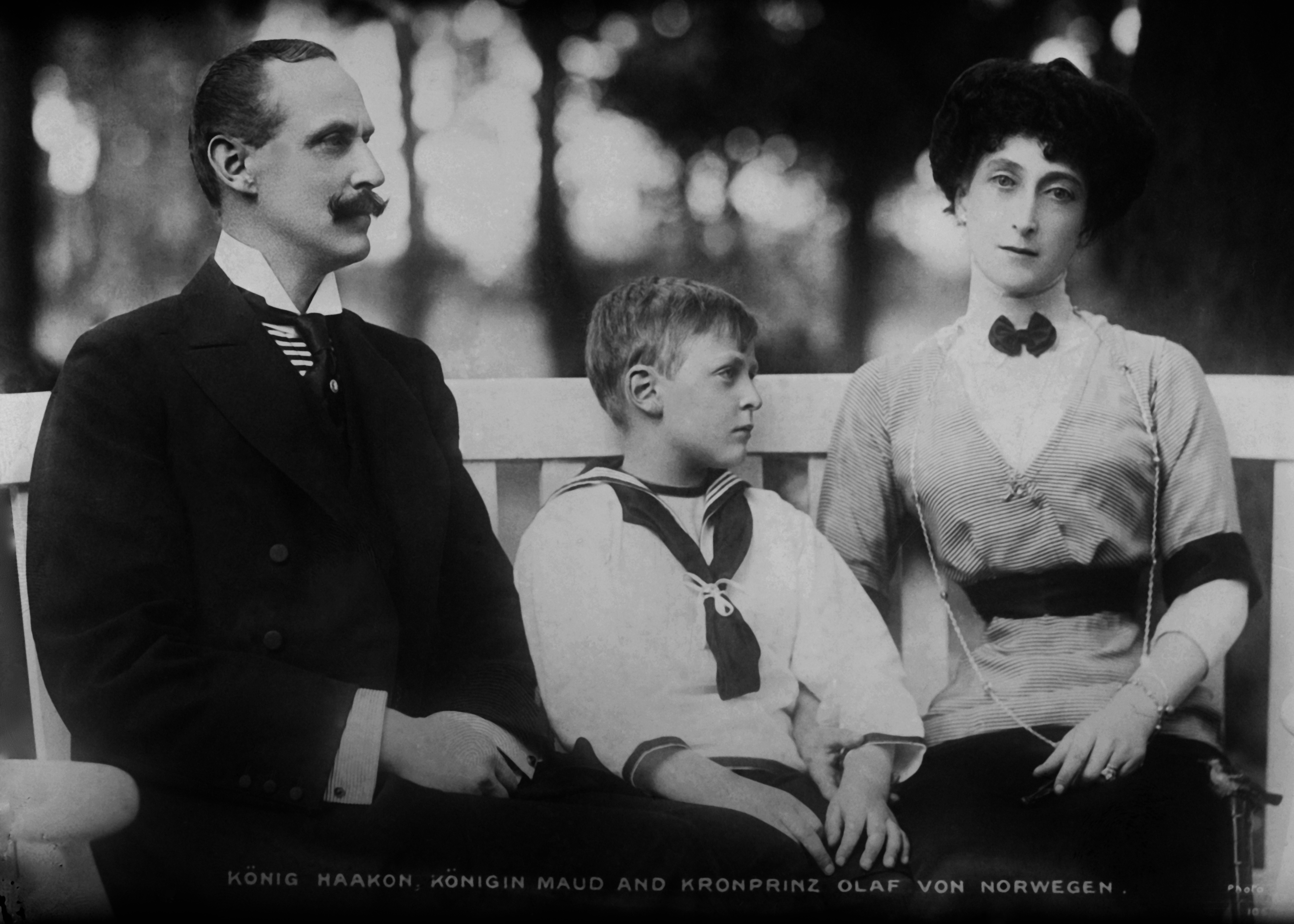
King Haakon gained much sympathy from the Norwegian people, travelling extensively throughout Norway to connect with his subjects. As king, Haakon endeavored to redefine the role of the monarchy in egalitarian Norway and to find a balance between the informal Norwegian way of life and the monarchy's need for formal representation. Although the Constitution of Norway vests the King with considerable executive powers, in practice nearly all major governmental decisions were made by the Government (the Council of State) in his name. Haakon confined himself to non-partisan roles without interfering in politics, a practice continued by his son and grandson. However, his long rule gave him considerable moral authority as a symbol of the country's unity. The royal family also cultivated a public interest in winter sports, such as skiing, which was seen as a typical Norwegian pastime.
4.2. Neutrality and International Relations
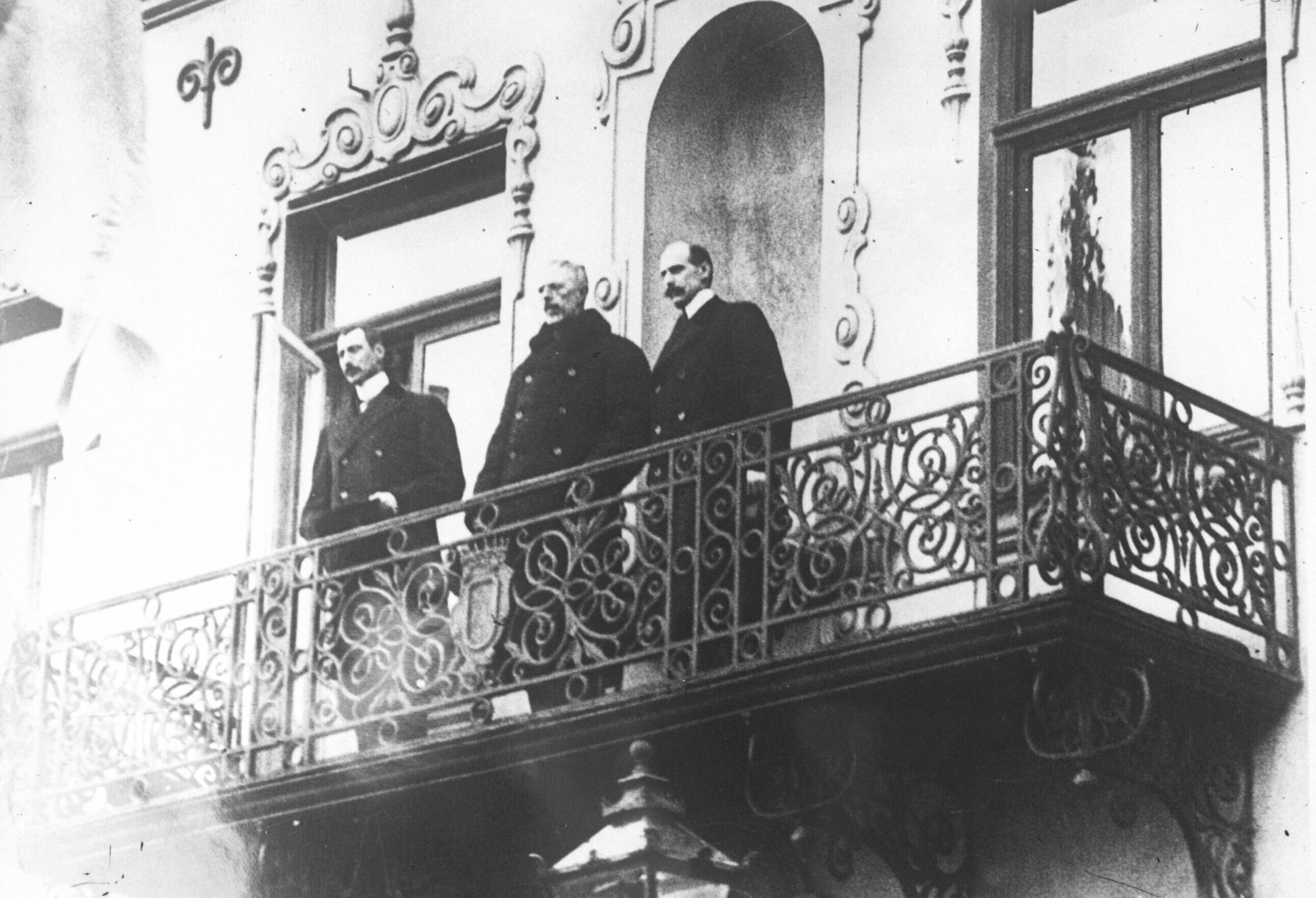
At the outbreak of the First World War in 1914, the Norwegian government advocated that Norway pursue a policy of neutrality. King Haakon supported this policy by participating in the so-called Meeting of the Three Kings held on 18 December 1914 in Malmö in Sweden. There, the three Scandinavian monarchs-King Haakon, King Christian X of Denmark (Haakon's brother), and King Gustav V of Sweden (Haakon's mother's cousin)-met along with their foreign ministers to discuss and emphasize the neutrality of the Nordic countries. In a joint declaration, they confirmed the three states' strict neutrality during the war. This meeting in 1914 was followed by another three-kings meeting in Kristiania in November 1917.
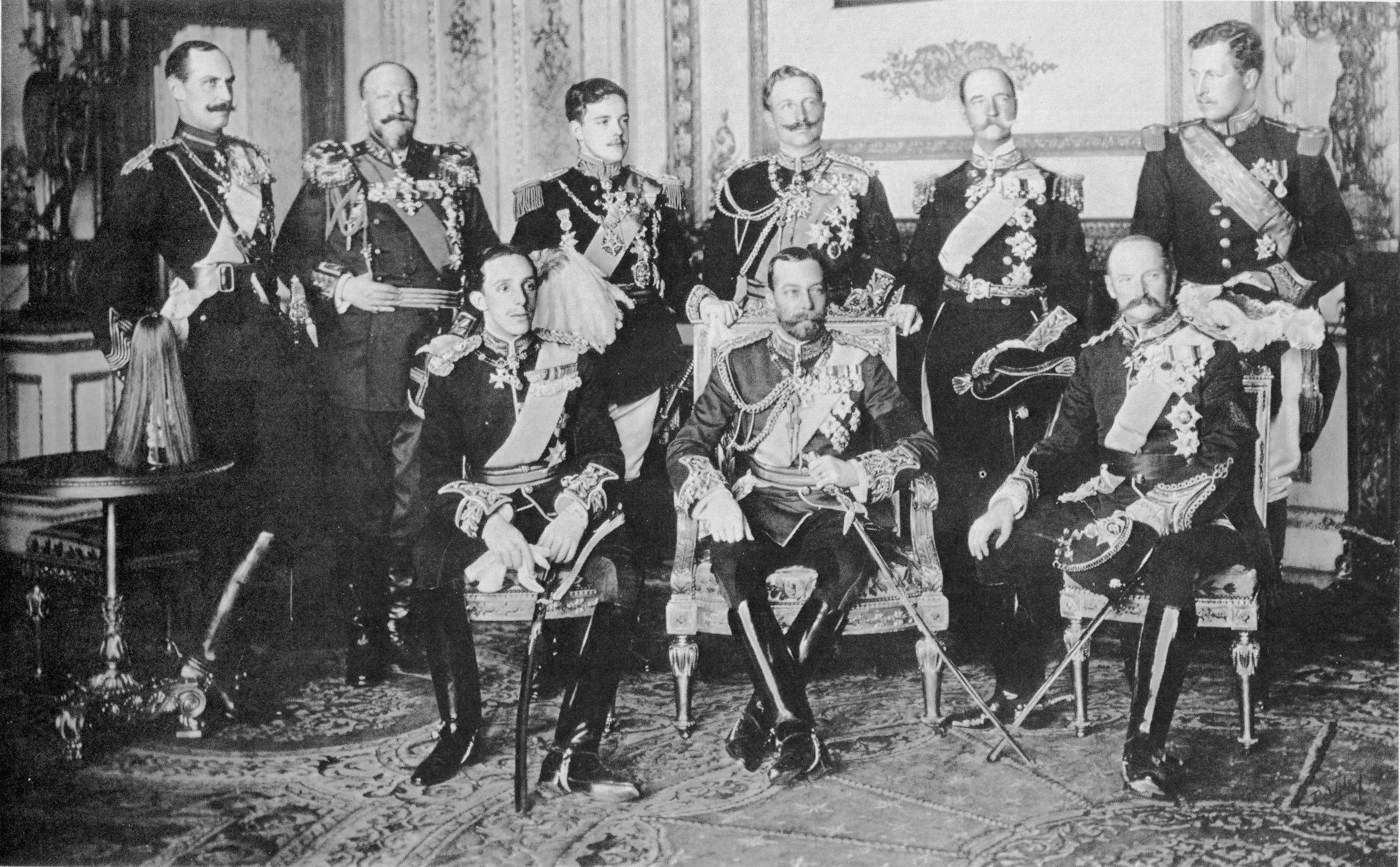
Haakon also maintained diplomatic relations through participation in international events, such as the funeral of his father-in-law, King Edward VII, on 20 May 1910, where he was photographed alongside numerous European sovereigns. In July 1907, he received King Chulalongkorn of Siam during his second European tour.
4.3. Domestic Policy and Social Aspects
In 1927, the Labour Party became the largest party in parliament, and early the following year Norway's first Labour Party government rose to power. The Labour Party was considered to be "revolutionary" by many, and the deputy prime minister at the time advised against appointing Christopher Hornsrud as Prime Minister. Haakon, however, refused to abandon parliamentary convention and asked Hornsrud to form a new government. In response to some of his detractors he stated, "I am also the King of the Communists" (Jeg er også kommunistenes kongeNorwegian). This statement demonstrated his commitment to a truly inclusive democracy, where the monarch represents all segments of society, regardless of political affiliation.
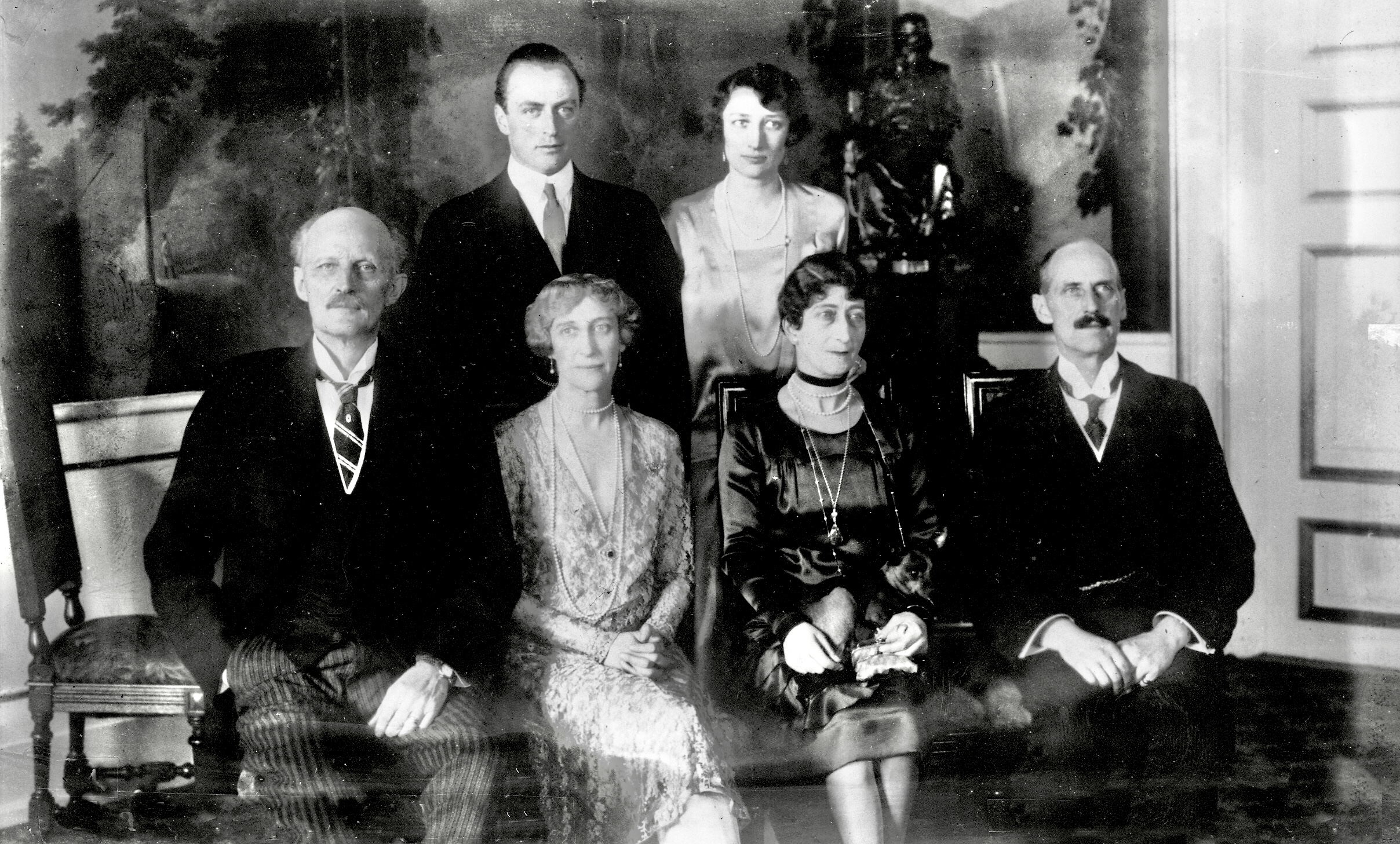
On 21 March 1929, Crown Prince Olav married his first cousin, Princess Märtha of Sweden, at the Oslo Cathedral. Princess Märtha was the daughter of Haakon's sister Princess Ingeborg and Prince Carl, Duke of Västergötland. It was the first royal wedding in Norway after the dissolution of the union, and the alliance was met with great enthusiasm, also in Sweden, seen as a sign that all the disharmony after the events of 1905 had now passed. Crown Prince Olav and Crown Princess Märtha were to have three children: Ragnhild (1930-2012), Astrid (born 1932), and Harald (born 1937), who would become king in 1991.
During the Eastern Greenland Case, a territorial dispute between Norway and Denmark about the sovereignty over Eastern Greenland, a very tense atmosphere prevailed. On 5 April 1933, Norway lost the arbitration case which had been submitted to the Permanent Court of International Justice in The Hague. The next day, Aftenposten quoted across the front page the telegram King Haakon had sent to his brother King Christian X: "Have received the wording of the sentence and congratulate Denmark on the result."
Queen Maud died unexpectedly while visiting the United Kingdom on 20 November 1938, aged 68. In 1939, King Haakon toured southeast Montana and parts of the proposed secessionist state of Absaroka, with supporters of the secession movement claiming this event as formal recognition of their state.
An anecdote of Haakon's early reign involved Japan. In 1909, after hearing of a winter military training accident in Japan that resulted in many deaths (referring to the Hakkōda Mountains incident), King Haakon VII, believing that Norwegian skis could have prevented such a disaster, sent two pairs of skis to Emperor Meiji as a gesture of sympathy. This event is regarded as a catalyst for the beginning of ski exchange between Japan and Norway.
5. World War II and Exile
This section details King Haakon VII's pivotal role as a national hero during World War II, particularly focusing on Norway's struggle against Nazi Germany and his unwavering leadership from exile.
5.1. German Invasion and Norwegian Campaign
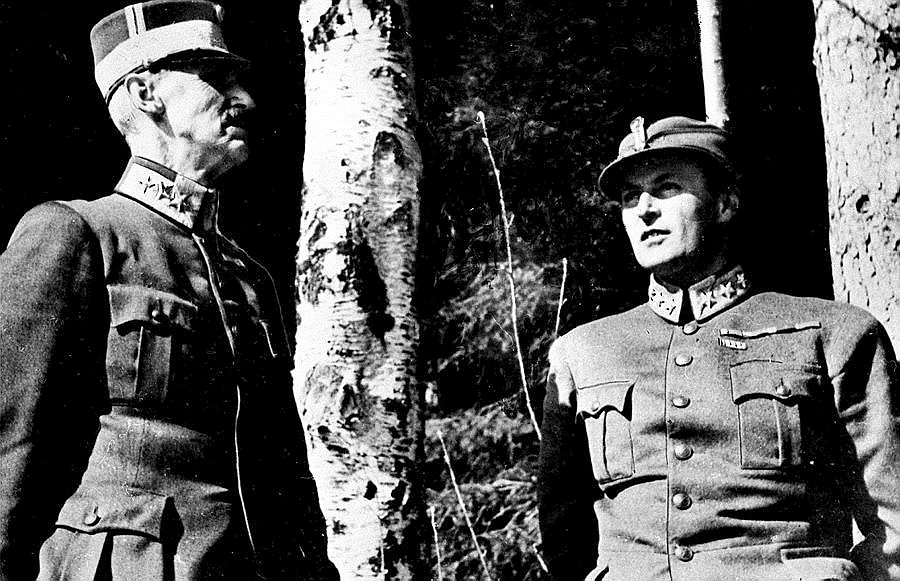
Norway was invaded by the naval and air forces of Nazi Germany during the early hours of 9 April 1940. The German naval detachment sent to capture Oslo was opposed by Oscarsborg Fortress. The fortress fired at the invaders, sinking the heavy cruiser HMS Blücher and damaging the heavy cruiser HMS Lützow, with heavy German losses that included many soldiers, Gestapo agents, and administrative personnel who were to have occupied the Norwegian capital. This led to the withdrawal of the rest of the German flotilla, preventing the invaders' planned dawn occupation of Oslo. The Germans' delay in occupying Oslo, along with swift action by the President of the Storting, C. J. Hambro, created the opportunity for the royal family, the cabinet, and most of the 150 members of the Storting (parliament) to make a hasty departure from the capital by special train.
The Storting first convened at Hamar the same afternoon, but with the rapid advance of German troops, the group moved on to Elverum. The assembled Storting unanimously enacted a resolution, the so-called Elverum Authorization, granting the cabinet full powers to protect the country until such time as the Storting could meet again.
5.2. Refusal to Abdicate and German Ultimatum
The next day, Curt Bräuer, the German Ambassador to Norway, demanded a meeting with Haakon. The German diplomat called on Haakon to accept Adolf Hitler's demands to end all resistance and appoint Vidkun Quisling as prime minister. Quisling, the leader of Norway's fascist party, the Nasjonal Samling, had declared himself prime minister hours earlier in Oslo as head of what would be a German puppet government; had Haakon formally appointed him, it would effectively have given legal sanction to the invasion. Bräuer suggested that Haakon follow the example of the Danish government and his brother, Christian X, which had surrendered almost immediately after the previous day's invasion, and threatened Norway with harsh reprisals if it did not surrender. Haakon told Bräuer that he could not make the decision himself, but could only act on the advice of the Government.
In a meeting in Nybergsund, the King reported the German ultimatum to the cabinet sitting as a council of state. Haakon told the cabinet that he was deeply affected by the responsibility laid on him if the German demand was rejected, acknowledging that the responsibility for the calamities that would befall people and country was grave. He stated his position clearly: "For my part I cannot accept the German demands. It would conflict with all that I have considered to be my duty as King of Norway since I came to this country nearly thirty-five years ago."
Haakon went on to say that he could not appoint Quisling as prime minister, since he knew neither the people nor the Storting had confidence in him. However, if the cabinet felt otherwise, the King said he would abdicate so as not to stand in the way of the Government's decision.
Nils Hjelmtveit, Minister of Church and Education, later wrote:
"This made a great impression on us all. More clearly than ever before, we could see the man behind the words; the king who had drawn a line for himself and his task, a line from which he could not deviate. We had through the five years [in government] learned to respect and appreciate our king, and now, through his words, he came to us as a great man, just and forceful; a leader in these fatal times to our country."
Inspired by Haakon's stand, the government unanimously advised him not to appoint any government headed by Quisling. Within hours, it telephoned its refusal to Bräuer. That night, NRK broadcast the government's rejection of the German demands to the Norwegian people. In that same broadcast, the government announced that it would resist the German invasion as long as possible, and expressed their confidence that Norwegians would lend their support to the cause.
After Norway was eventually conquered, Quisling transformed the country into a one-party fascist state and recruited 6,000 Norwegians to fight alongside the Germans on the Russian front. A very small percentage of the population, around two percent, supported Quisling, and many joined the Norwegian resistance movement. After the war, Quisling was convicted of treason and executed.
5.3. Government in Exile and Role as a Symbol of Resistance
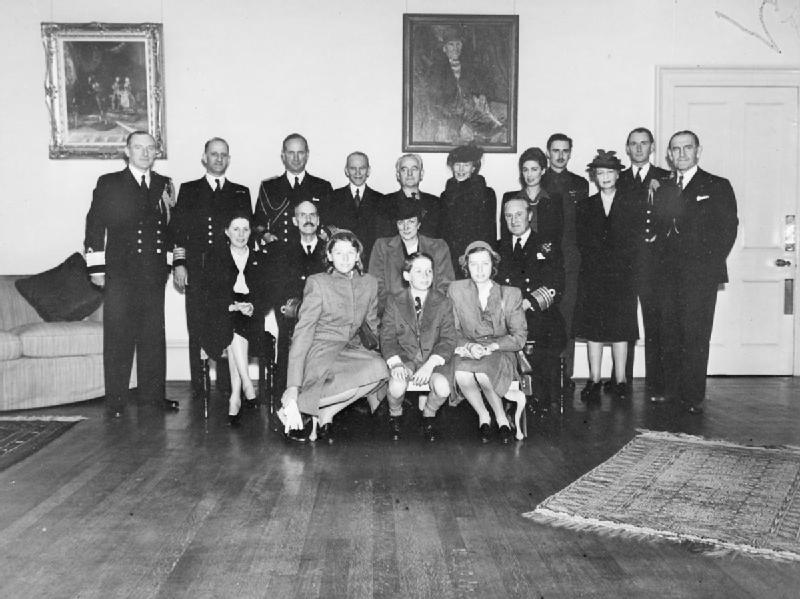
On 11 April 1940, in an attempt to wipe out Norway's unyielding king and government, LuftwaffeGerman bombers attacked Nybergsund, destroying the small town where the Government was staying. Neutral Sweden was only 16 mile away, but the Swedish government decided it would "detain and incarcerate" King Haakon if he crossed their border, a decision Haakon never forgave. The Norwegian king and his ministers took refuge in the snow-covered woods and escaped harm, continuing farther north through the mountains toward Molde on Norway's west coast. As the British forces in the area lost ground under Luftwaffe bombardment, the King and his party were taken aboard the British cruiser HMS Glasgow at Molde and conveyed a further 0.6 K mile (1.00 K km) north to Tromsø, where a provisional capital was established on 1 May. Haakon and Crown Prince Olav took up residence in a forest cabin in Målselvdalen valley in inner Troms County, where they would stay until evacuation to the United Kingdom. During their time in Tromsø, they were protected by the local rifle association, which used Krag-Jørgensen rifles extensively.
The Allies had a fairly secure hold over northern Norway until late May. The situation was dramatically altered, however, by their deteriorating situation in the Battle of France. With the Germans rapidly overrunning France, the Allied high command decided that the forces in northern Norway should be withdrawn. The royal family and Norwegian government were evacuated from Tromsø on 7 June aboard HMS Devonshire with a total of 461 passengers. This evacuation became extremely costly for the Royal Navy when the German warships HMS Scharnhorst and HMS Gneisenau attacked and sank the nearby aircraft carrier HMS Glorious with its escorting destroyers HMS Acasta and HMS Ardent. HMS Devonshire did not rebroadcast the enemy sighting report made by HMS Glorious as it could not disclose its position by breaking radio silence. No other British ship received the sighting report, and 1,519 British officers and men and three warships were lost. HMS Devonshire arrived safely in London and King Haakon and his Cabinet set up a Norwegian government in exile in the British capital.
Initially, King Haakon and Crown Prince Olav were guests at Buckingham Palace, but at the start of the London Blitz in September 1940, they moved to Bowdown House in Berkshire. The construction of the adjacent RAF Greenham Common airfield in March 1942 prompted another move to Foliejon Park in Winkfield, near Windsor, in Berkshire, where they remained until the liberation of Norway. Haakon also spent time at Carbisdale Castle in Sutherland, Scotland, made available for his use by Theodore Salvesen, a ship-owner of Norwegian extraction.
The King's official residence was the Norwegian Legation at 10 Palace Green, Kensington, which became the seat of the Norwegian government in exile. Here Haakon attended weekly Cabinet meetings and worked on the speeches which were regularly broadcast by radio to Norway by the BBC World Service. These broadcasts helped to cement Haakon's position as an important national symbol to the Norwegian resistance movement. Many broadcasts were made from Saint Olav's Norwegian Church in Rotherhithe, where the royal family were regular worshippers.
Meanwhile, Hitler had appointed Josef Terboven as ReichskommissarGerman for Norway. On Hitler's orders, Terboven attempted to coerce the Storting to depose the King; the Storting declined, citing constitutional principles. A subsequent ultimatum was made by the Germans, threatening to intern all Norwegians of military age in German concentration camps. With this threat looming, the Storting's representatives in Oslo wrote to their monarch on 27 June, asking him to abdicate. The King declined, politely replying that the Storting was acting under duress. The King gave his answer on 3 July, and proclaimed it on BBC radio on 8 July.
After one further German attempt in September to force the Storting to depose Haakon failed, Terboven finally decreed that the royal family had "forfeited their right to return" and dissolved the democratic political parties.
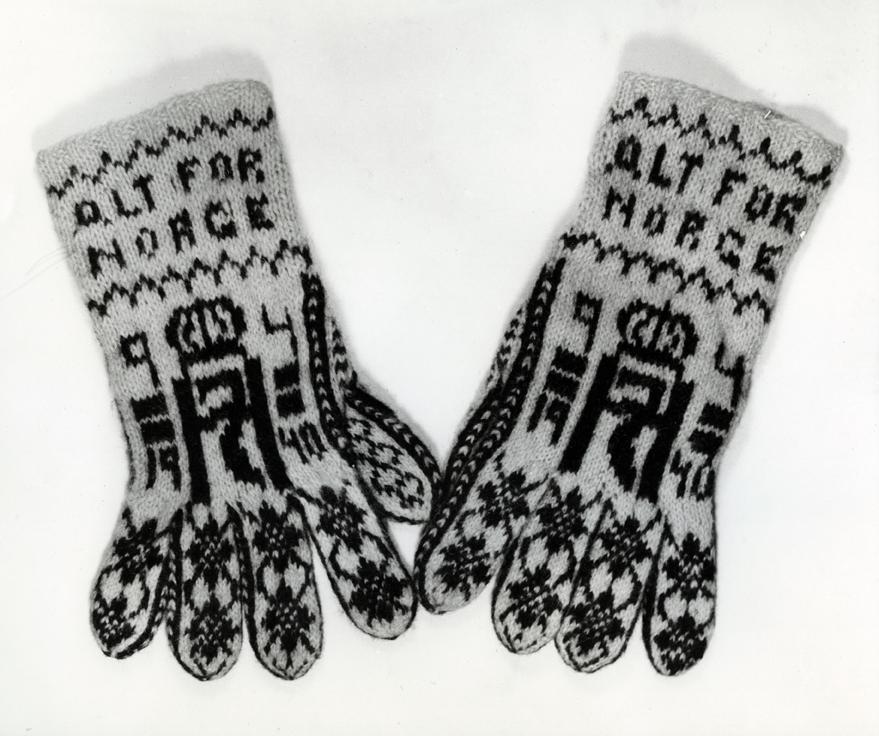
During Norway's five years under German control, many Norwegians surreptitiously wore clothing or jewellery made from coins bearing Haakon's "H7" monogram as symbols of resistance to the German occupation and of solidarity with their exiled King and Government, just as many people in Denmark wore his brother's monogram on a pin. The King's monogram was also painted and otherwise reproduced on various surfaces as a show of resistance to the occupation.
5.4. Return to Norway
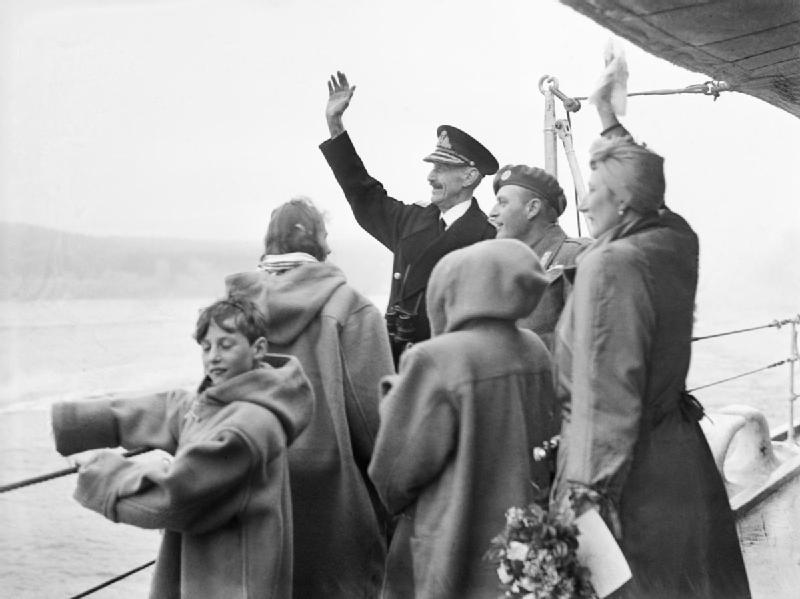
Nazi Germany controlled Norway until the capitulation of German forces in Europe on 8 May 1945. After the end of the war, Crown Prince Olav and five government ministers returned to a liberated Norway on 13 May 1945. Haakon and the rest of the Norwegian royal family returned to Norway aboard the cruiser HMS Norfolk, arriving with the First Cruiser Squadron to cheering crowds in Oslo on 7 June 1945, exactly five years after they had been evacuated from Tromsø.
6. Post-War Years
Following World War II, King Haakon VII played a crucial role in Norway's reconstruction and reunification, continuing to serve as a unifying figure until his later years.
6.1. Reconstruction and National Unity
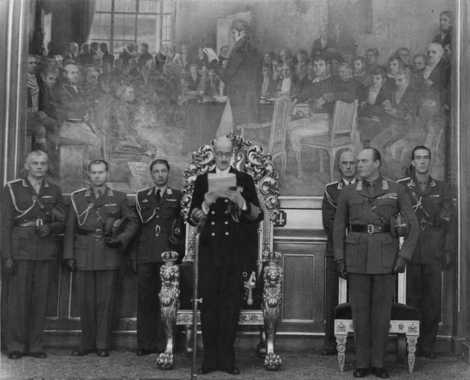
After his return, Haakon did not continue the political role that he had played during the war, and limited himself to his constitutional duties as head of state. In the late summer of 1945, he went on an extensive tour of Norway to examine the war damage and to give consolation to the population. Because of his role during the war and his personal integrity, Haakon VII was considered the highest moral authority in the country and enjoyed great esteem in all classes of the population.
In 1947, the Norwegian people, by public subscription, purchased the royal yacht HNoMY Norge for the King. In 2012, this was one of only two royal yachts owned by European royal families, the other belonging to Queen Margrethe II of Denmark, his great-niece. In 1952, he attended the funeral of his wife's nephew, King George VI, and was observed openly weeping.
6.2. Later Life and Health
King Haakon VII lived to see two of his great-grandchildren born: Haakon Lorentzen (born 23 August 1954) and Ingeborg Lorentzen (born 3 February 1957). His granddaughter, Princess Ragnhild, married businessman Erling Lorentzen on 15 May 1953, being the first member of the new Norwegian royal family to marry a commoner. Sadly, Crown Princess Märtha, Haakon's daughter-in-law, died of cancer on 5 April 1954.
King Haakon VII fell in his bathroom at the Bygdøy Royal Estate (Bygdøy kongsgård) in July 1955. This fall, which occurred just a month before his eighty-third birthday, resulted in a fracture to the thighbone. Although there were few other complications resulting from the fall, the King was left using a wheelchair. The once-active King was said to have been depressed by his resulting helplessness and began to lose his customary involvement and interest in current events. With Haakon's loss of mobility, and as his health deteriorated further in the summer of 1957, Crown Prince Olav appeared on behalf of his father on ceremonial occasions and took a more active role in state affairs.
The Norwegian Post Office issued several sets of commemorative postage stamps to honour their King:
- 1952 - Two stamps issued 2 August to celebrate the King's 80th birthday.
- 1955 - Two stamps issued 25 November to celebrate the King's 50 years on the throne.
- 1957 - Two stamps issued 3 August to celebrate the King's 85th birthday.
An additional set was issued in 1972 to commemorate the late King's 100th anniversary of his birth.
7. Death and Succession
The final period of King Haakon VII's life concluded with his peaceful passing and the smooth transition of the Norwegian throne to his son.
7.1. Death
Haakon died at the Royal Palace in Oslo on 21 September 1957, at the age of 85. He was the last surviving son of King Frederick VIII of Denmark.
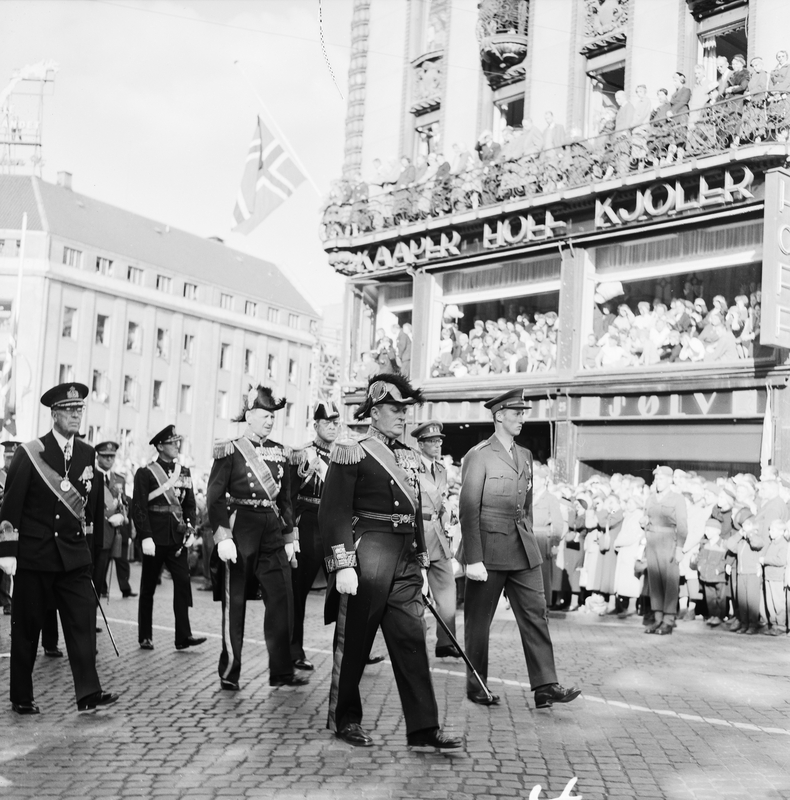
His funeral took place on 1 October 1957. He was buried alongside his wife in the white sarcophagus in the Royal Mausoleum at Akershus Fortress.
7.2. Succession of Olav V
At his death, Haakon was succeeded by his only child and son, who ascended to the throne as Olav V. This ensured the continuity of the newly established Norwegian monarchy.
8. Legacy
King Haakon VII is regarded by many as one of the greatest Norwegian leaders of the pre-war period, managing to hold his young and fragile country together in unstable political conditions. He was ranked highly in the Norwegian of the Century poll in 2005. His unwavering commitment to democratic values, his steadfast refusal to compromise with authoritarian regimes, and his profound role in uniting the nation during its darkest hour solidified his legacy as a moral authority and a cornerstone of modern Norwegian identity. Haakon VII's reign demonstrated that a monarch could truly serve as a unifying symbol for a democratic people.
8.1. National Symbol and Moral Authority
Haakon VII is highly regarded in Norwegian society for his integrity and his role as a unifying national symbol, particularly after World War II. His personal decision to reject Nazi Germany's demands to legitimize the Quisling regime, even at the cost of abdication, resonated deeply with the Norwegian people and solidified his image as a defender of democratic principles. His broadcasts from exile during the occupation further reinforced his position as a powerful symbol of resistance and hope.
8.2. Contribution to Democracy and National Identity
His commitment to democratic principles was evident throughout his reign, notably in his willingness to accept a monarchy determined by popular referendum and his declaration of being "the King of the Communists," demonstrating his belief in the monarch's role as a unifying figure above partisan politics. His actions during the war cemented the idea that the Norwegian monarchy was a symbol of national independence and a bulwark against tyranny, directly influencing the shaping of modern Norwegian identity and sovereignty. His legacy underscores the importance of moral leadership in times of crisis and the enduring strength of a nation united by shared values.
9. Honours and Awards
King Haakon VII received numerous national and international honours, military appointments, and other recognitions throughout his life, reflecting his significant diplomatic and state relations, and his impact beyond the political sphere.
9.1. National and Foreign Honours
Haakon VII held various honorary military appointments and received numerous decorations:
- Honorary Military Appointments**
- Admiral of the Royal Danish Navy, 20 November 1905, created by his father King Frederick VIII.
- Honorary Admiral of the Royal Navy.
- Honorary Lieutenant in the Royal Navy, 7 February 1901, created by his father-in-law King Edward VII.
- Honorary Colonel of the Royal Artillery.
- Honorary Colonel of the Norfolk Yeomanry, 11 June 1902 - 21 September 1957.
- Colonel-in-Chief, The Green Howards, 12 May 1942 - 21 September 1957.
- National Honours**
- Denmark:
- Knight of the Elephant, 3 August 1890.
- Cross of Honour of the Order of the Dannebrog, 3 August 1890.
- Grand Commander of the Dannebrog, 28 July 1912.
- King Christian X's Freedom Medal.
- Commemorative Medal for King Christian IX and Queen Louise's Golden Wedding anniversary.
- Commemorative Medal for King Christian IX's 100th birthday.
- Commemorative Medal for King Frederick VIII's 100th birthday.
- Norway:
- War Cross with Sword.
- Gold Medal for Outstanding Civic Achievement.
- Grand Master of the Order of St. Olav, 18 November 1905.
- Denmark:
- Foreign Honours**
- Austria: Grand Star of the Decoration of Honour for Services to the Republic of Austria.
- Belgium: Grand Cordon of the Order of Leopold (military), 2 October 1906.
- Brazil: Grand Cross of the Southern Cross, with Collar.
- Czechoslovakia:
- Grand Cross of the White Lion, 1937.
- Czechoslovak War Cross 1939-1945.
- Ethiopian Imperial Family: Collar of the Order of Solomon.
- Finland: Grand Cross of the White Rose, with Collar, 1926.
- French Third Republic:
- Grand Cross of the Legion of Honour.
- Cross of War (1939-1945).
- Médaille Militaire.
- Greek royal family:
- War Cross, 1940.
- Grand Cross of the Redeemer, 1947.
- Iceland: Grand Cross of the Falcon, with Collar, 1955.
- Italian royal family: Knight of the Annunciation, 12 April 1909.
- Empire of Japan: Collar of the Order of the Chrysanthemum.
- German imperial and royal family:
- Knight of the Black Eagle.
- Grand Cross of the Red Eagle.
- Mecklenburg Grand Ducal Family: Grand Cross of the Wendish Crown, with Crown in Ore.
- Netherlands: Grand Cross of the Netherlands Lion.
- Peru: Grand Cross of the Sun of Peru, in Diamonds, 1922.
- Poland: Knight of the White Eagle, 1930.
- Portuguese royal family:
- Grand Cross of the Sash of the Three Orders.
- Grand Cross of the Tower and Sword.
- Romanian royal family: Grand Cross of the Order of Carol I, with Collar.
- Russian imperial family:
- Knight of St. Andrew.
- Knight of St. Alexander Nevsky.
- Knight of the White Eagle.
- Knight of St. Anna, 1st Class.
- Knight of St. Stanislaus, 1st Class.
- Restoration (Spain): Knight of the Golden Fleece, with Collar, 16 July 1910.
- Sweden: Knight of the Seraphim, 30 May 1893.
- Thailand: Knight of the Order of the Royal House of Chakri.
- Turkish Imperial Family: Order of Osmanieh, 1st Class in Diamonds.
- United Kingdom:
- Honorary Grand Cross of the Bath (civil), 21 July 1896.
- Honorary Grand Cross of the Royal Victorian Order, 2 February 1901.
- Royal Victorian Chain, 9 August 1902.
- Knight of the Garter, 9 November 1906.
- Associate Bailiff Grand Cross of St. John, 12 June 1926.
- Queen Victoria Diamond Jubilee Medal.
- King Edward VII Coronation Medal.
9.2. Other Recognitions

The King Haakon VII Sea in East Antarctica is named in the king's honour, as is the entire plateau surrounding the South Pole, which was named King Haakon VII Vidde by Roald Amundsen when he in 1911 became the first human to reach the South Pole. In 1914, Haakon County, in the American state of South Dakota, was named in his honour.
Two Royal Norwegian Navy ships have been named after King Haakon VII:
- HNoMS King Haakon VII, an escort ship in commission from 1942 to 1951.
- HNoMS Haakon VII (A537), a training ship in commission from 1958 to 1974.
For his struggles against the Nazi regime and his effort to revive the Holmenkollen ski festival following World War II, King Haakon VII earned the Holmenkollen medal in 1955. He shared this honour with Hallgeir Brenden, Veikko Hakulinen, and Sverre Stenersen. He is one of only 11 people not primarily famous for Nordic skiing to receive this honour. The others include Norway's Stein Eriksen, Borghild Niskin, Inger Bjørnbakken, Astrid Sandvik, King Olav V (his son), Erik Håker, Jacob Vaage, King Harald V (his paternal grandson), and Queen Sonja (his paternal granddaughter-in-law), and Sweden's Ingemar Stenmark. He also became an Honorary Citizen of Largs, Scotland.
10. In Popular Culture
King Haakon VII's life and reign, particularly his steadfastness during World War II, have been portrayed in various forms of media, contributing to his enduring image in the public consciousness.
10.1. Portrayals in Film and Television
Haakon was portrayed by Jakob Cedergren in the 2009 NRK drama series Harry & Charles, a series that focused on the events leading up to the election of King Haakon in 1905.
Jesper Christensen portrayed the King in the 2016 film The King's Choice (Kongens nei). This film was based on the events surrounding the German invasion of Norway in 1940 and the King's pivotal decision to resist. The film won widespread critical acclaim and was Norway's submission for the Academy Award for Best Foreign Language Film at the 89th Academy Awards, making the shortlist of nine finalists in December 2016.
Haakon was also portrayed by Søren Pilmark in the 2020 NRK drama series Atlantic Crossing, which chronicled Crown Princess Märtha's experiences and role during the royal family's exile from 1939 to 1945. These portrayals reflect the public's continued interest in and interpretation of his life and actions, particularly his moral leadership during the war.
11. Ancestry
11.1. Genealogical Lineage
King Haakon VII's ancestry illustrates his deep connections to various European royal families:
| 1. Haakon VII of Norway | |
|---|---|
| 2. Frederick VIII of Denmark | |
| 3. Princess Louise of Sweden and Norway | |
| 4. Christian IX of Denmark | |
| 5. Princess Louise of Hesse-Kassel | |
| 6. Charles XV of Sweden and Norway | |
| 7. Princess Louise of the Netherlands | |
| 8. Friedrich Wilhelm, Duke of Schleswig-Holstein-Sonderburg-Glücksburg | |
| 9. Princess Louise Caroline of Hesse-Kassel | |
| 10. Prince William of Hesse-Kassel | |
| 11. Princess Charlotte of Denmark and Norway | |
| 12. Oscar I of Sweden and Norway | |
| 13. Princess Josephine of Leuchtenberg | |
| 14. Prince Frederick of the Netherlands | |
| 15. Princess Louise of Prussia |